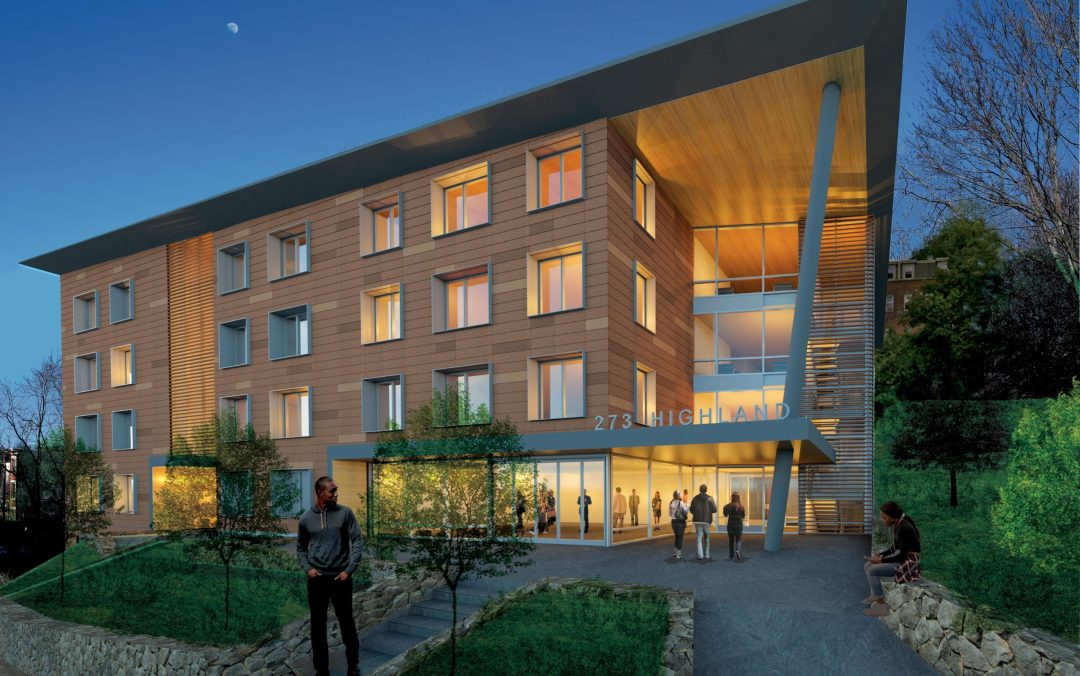

When presented with an aspirational program for housing, we can’t help but get excited. Recently Studio G Architects partnered with Rees-Larkin Development to create an ambitious developer response for Parcels 2 & 4 of the City of Boston Department of Neighborhood Development (DND) E+ Marcella Highland RFP. Our local development team recognized early in the design process that new development in the unique and historic Highland Park neighborhood should be sensitive to its storied history, reflect a new 21st century epoch, face the risks of climate change head on, and take advantage of advances in building and systems technologies. As such, our proposal goes beyond the requirements of the RFP by implementing Passive House standards and achieving E+ (energy positive) in two different housing typologies, as well as exceeding the affordability guidelines. Our design is fresh, innovative, green, and community-oriented.

Highland Park History
The DND-owned parcels in this RFP are in a unique area of Boston with deep historical roots tracing to the founding of our city. Highland Park buildings track and reflect key historic periods of the city’s history through their architectural character, up to the current day. The neighborhood is listed on the National Register of Historic Places.
Established in 1630 as a farming settlement, Highland Park was of strategic importance to the colonists during the Revolutionary War due to sweeping views of Boston Harbor and the Neck. The district was developed throughout the 19th century, first by a few wealthy businessmen with country estates; later farms were subdivided into more estates and large homes. Highland Park is unique in its diversity of architectural styles as well as the range of typologies: farmhouses, estates, brick rowhouses and triple deckers abound.
By the 1950’s, Highland Park was a predominantly African American neighborhood, subjected to redlining, public and private neglect, and abandonment of many properties. This legacy remains visible in today’s urban context, with many vacant parcels, including these long-held city parcels.
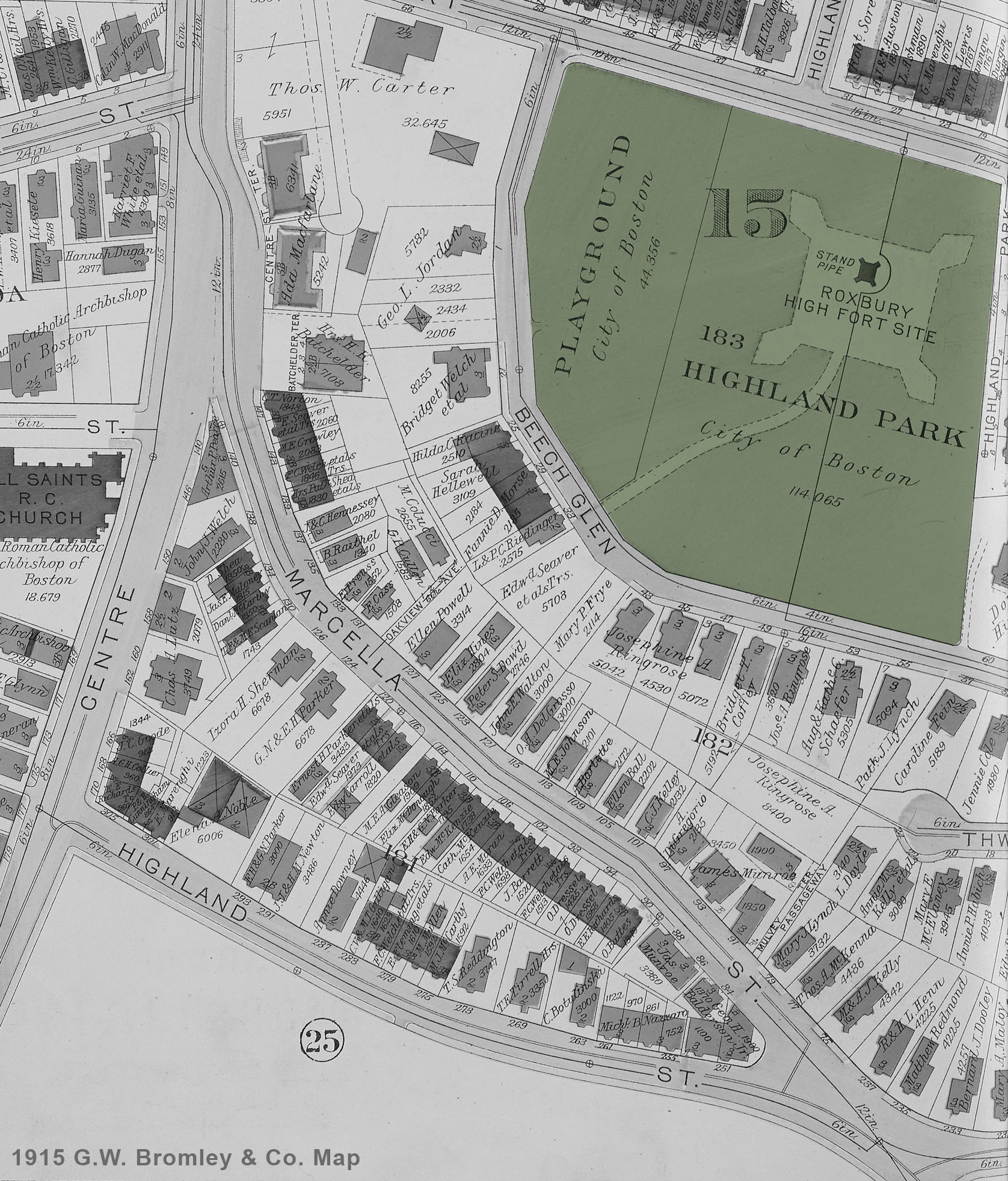
Urban Design Context
Located on the steep southwestern slope of Highland Park, the Marcella and Highland Streets neighborhood lies between Fort Hill and DPW’s salt shed, distinguished by a 100’ change in elevation. The location is transit-oriented and the area has ample open space and recreational facilities.
Formerly a strong residential neighborhood the once densely built neighborhood of Marcella and Highland Streets is now pocketed with vacant lots. The buildings which remain offer a uniquely rich urban context of diverse architectural styles and elements. The steeply sloped neighborhood with Roxbury Puddingstone outcroppings and 19th century stone walls dispersed throughout offers a strong framework for new development and opportunities for great views.
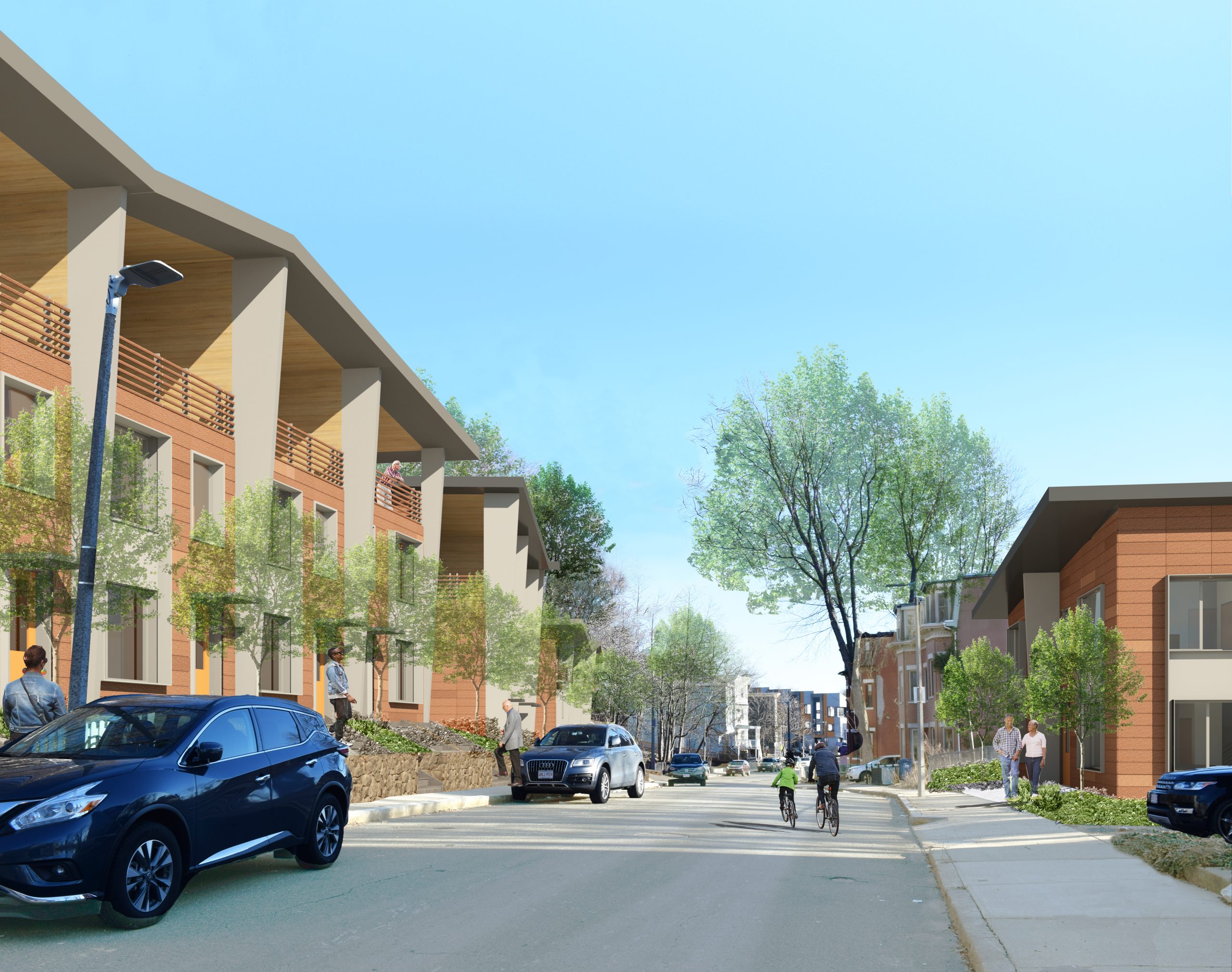
Reknitting the Urban Fabric
Designed to reknit the residential fabric of the neighborhood and provide the connectivity desired by the Highland Park community, new rowhouse buildings (Parcel 2) and a multi-family building (Parcel 4) are sited to reintegrate the deteriorated and discontinuous street line. The 14 new rowhouses tracking the curving street are scaled to reflect and complement existing rowhouse and woodframe buildings, resulting in buildings that vary in length and number of units. The multifamily building with 23 flats has more floors than nearby housing but respects the height and scale of the existing housing by nestling into the street slope with at-grade entry to the lobby. Because the adjacent houses are almost a full story above the street, the roofline is consistent with those of existing buildings.
In both packages walls built from site-harvested stone help mitigate the grade changes and define the boundaries between the public sidewalk and the properties. Trees along the sidewalk edge further define and enhance the streetscape. Two public paths are proposed across the properties, one up the hill to Marcella and another to a community garden on Beech Glen which links to Highland Park at the summit, providing the community with the pedestrian connections they desire.
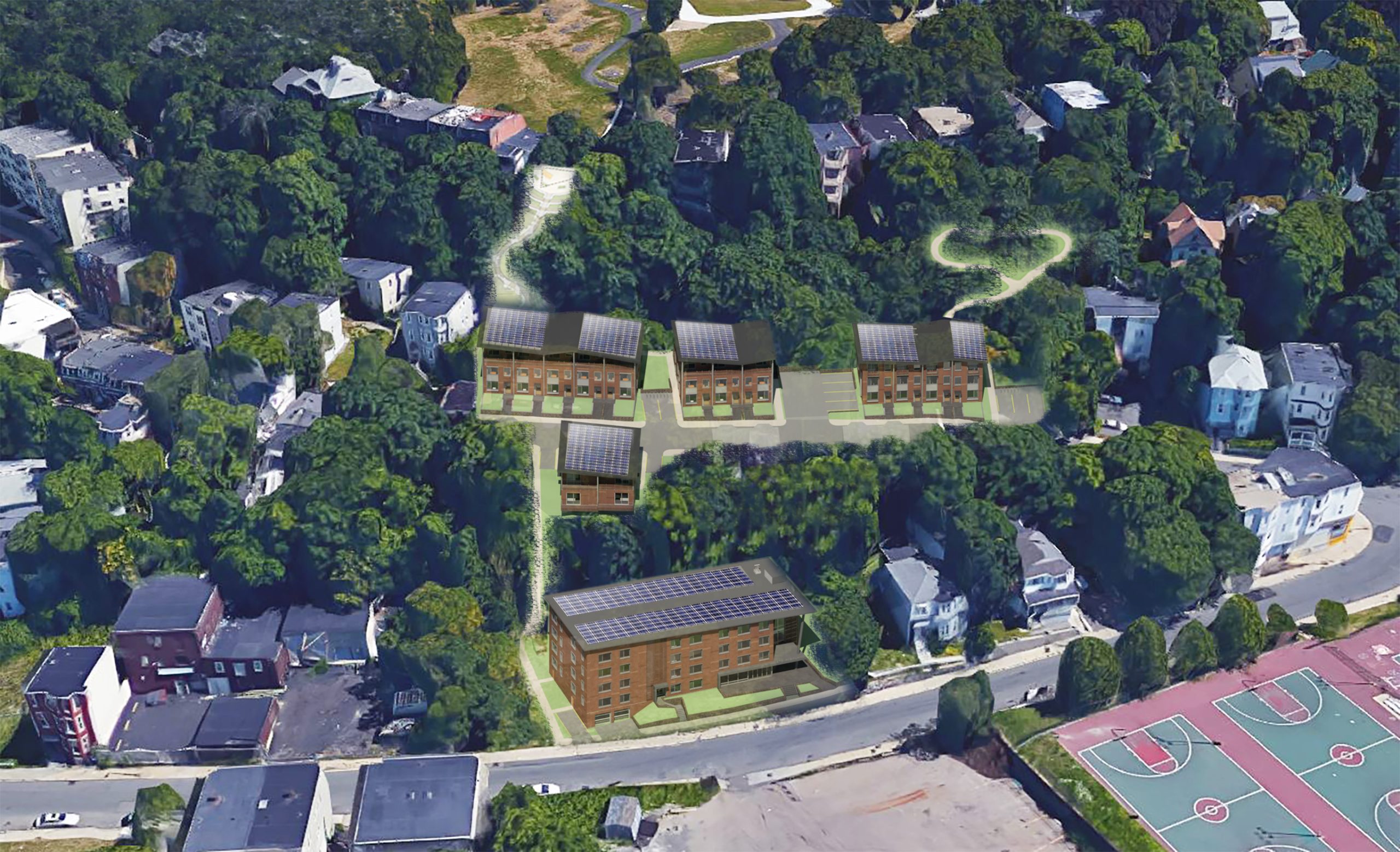
Building Design
The designs of both parcels exude a modern unique character which contributes and enhances the neighborhood’s vibrant architectural mix and expresses the green building agenda.
Terracotta rainscreen clad rowhouses at Parcel 2 are topped with a standing seam metal folded roof plane which connects the several buildings into a coherent whole. Metal clad fins support a 3’ deep roof overhang, frame the rowhouses and provide privacy between them. Front doors with canopies cover each unit entry. Generous window openings are accentuated with projecting metal plate frames. Ganged windows with infill panels encased in projecting metal plates are reminiscent of bay windows and punctuate the façade, creating a rhythm across the building face. Top floor balconies on 3-story rowhouses offer additional private outdoor space and opportunities for interaction with neighbors. All these elements and variations combine across the individual buildings, yielding a dynamic presence to the street, contributing to and being respectful of the neighboring context.
At Parcel 4 the building mass is simple—a main body, broken by a vertical segment of terra cotta ‘baguettes’ screening mechanical ventilation and egress stair behind, and a glazed circulation volume which steps back from the street. The façade at the units is defined by an ordered pattern of boxed windows and terracotta cladding, reflective of the regularity found in neighboring residential buildings. The large windows are boxed by projecting plate metal-frames and provide ample daylight and views for the units within. The boxes provide passive shading to the windows. The building is angled along Highland Street, with the lobby stepped back to create a semi-public entry plaza. Bordered by seat walls and planting beds, partially sheltered by the high overhanging roof, the plaza is an ideal gathering space for residents, neighbors, and artists in the arts/workspace. Stepping down to 3’ at the sidewalk, terraced planted beds provide visual interest for passing pedestrians while shielding the garage entry from the pedestrian entry.
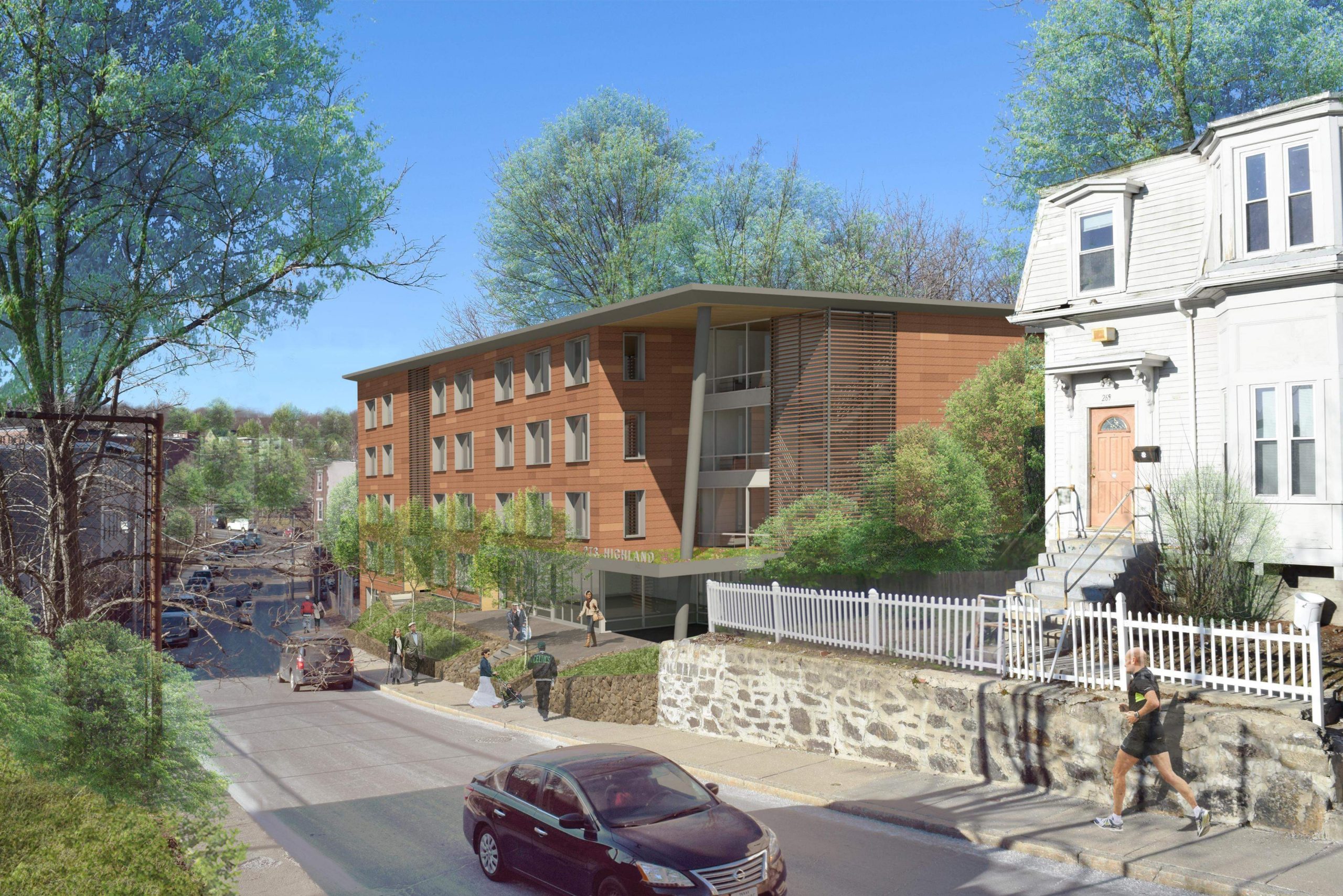
Carbon Neutral
The proposed buildings were designed with a holistic, sustainable approach to generate an energy positive project that meets Passive House requirements and LEED Platinum, exceeds Energy Star, and establishes a new benchmark for urban, sustainable living. The design targets Net Energy Positive, producing more energy than the building consumes on an annual basis.
Energy positive and near-net zero high performance buildings with extremely low annual utility bills will be a significant benefit to homeowners and, increasingly, a marketing differentiator as shown by the rapid sale of already built E+ homes.
Based on optimized building envelopes, our engineering team was able to decrease the HVAC system size to meet the low building energy demands. With the roof-mounted PV system, the design achieves the E+/Net Energy Positive target. The project will meet the highest EnergyStar Standard requirements, as well as the indoor airPlus and WaterSense programs.
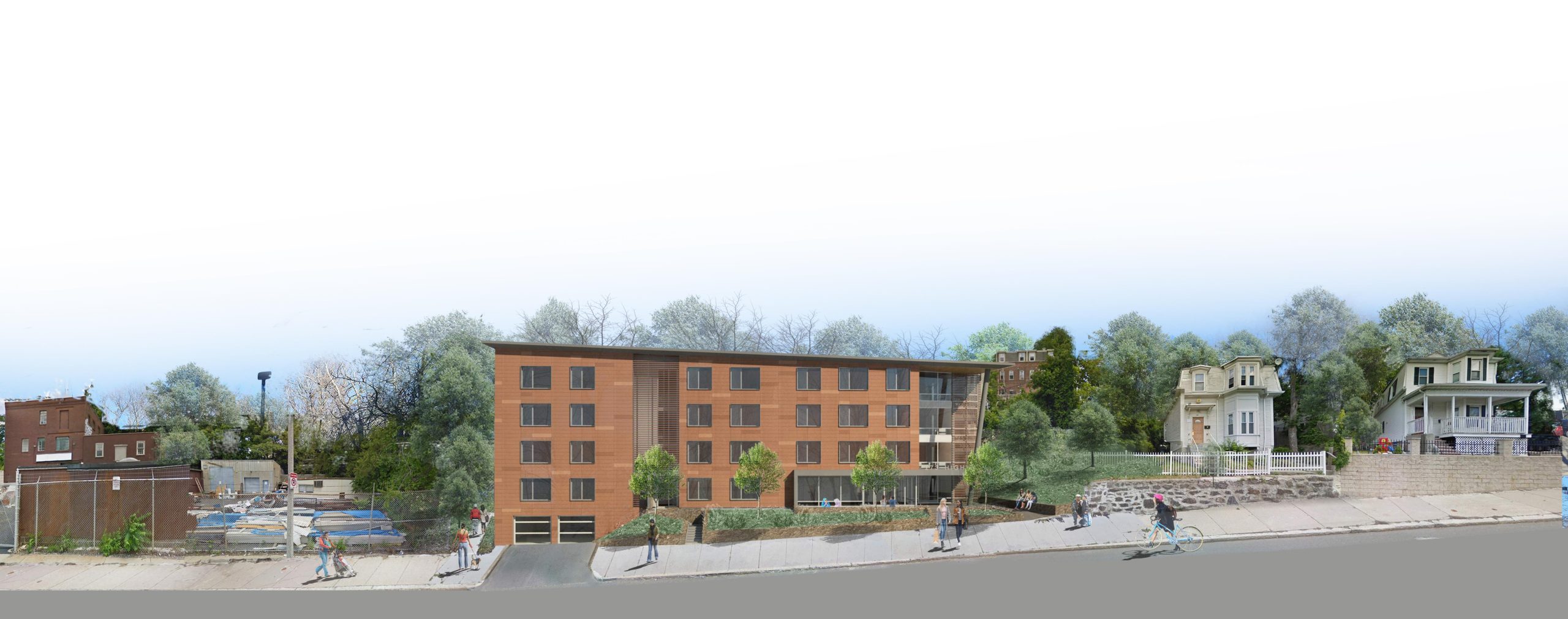
Affordable and Work Force Housing
The proposed income-mix for the development extends affordability beyond the guidelines set forth in the RFP – with deeper income targeting over a greater number of units – while still falling within the spirit of those guidelines. The inclusion of Low Income Housing Tax Credits (LIHTC) in our financing plan allows for this deeper income targeting: 60% AMI (Area Median Income) and 30% AMI units rather than 80% AMI units.
The proposed limited-equity cooperative structure will allow the development to BOTH provide the opportunity for resident ownership AND provide that opportunity to lower-income families. The deeper income targeting offered by our proposal, with homes targeted to families at 60% and 30% of AMI, would not be possible in a structure that involved the sale of individual, or single-family, homes in fee-simple interest.

Combined Development for Success
In summary our proposed combination of the Packages 2 and 4 is advantageous in at least two ways.
Firstly, a limited equity cooperative financed with low-income housing tax credits (LIHTC’s) depends on the economies of scale inherent in the greater number of units in a combined project. Due to the tremendous value of the tax credits, an approach that utilizes LIHTC’s is arguably the only way to achieve deep-income targeting in the project; in terms of the use of DND resources it is certainly the most efficient way to do so.
Secondly, combining the two Packages will allow for one of the largest examples regionally of a development constructed to Passive House standards.

